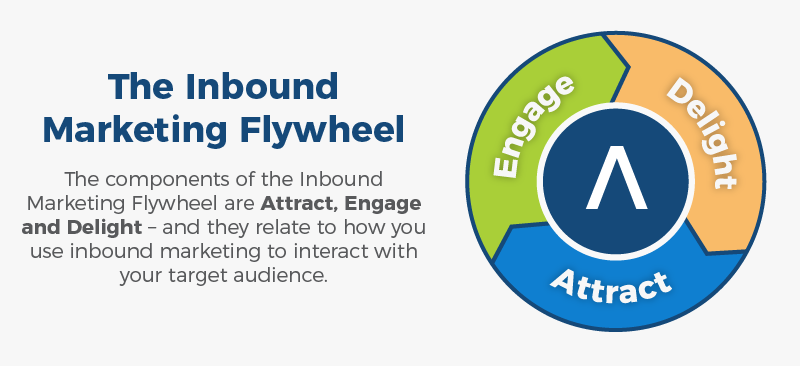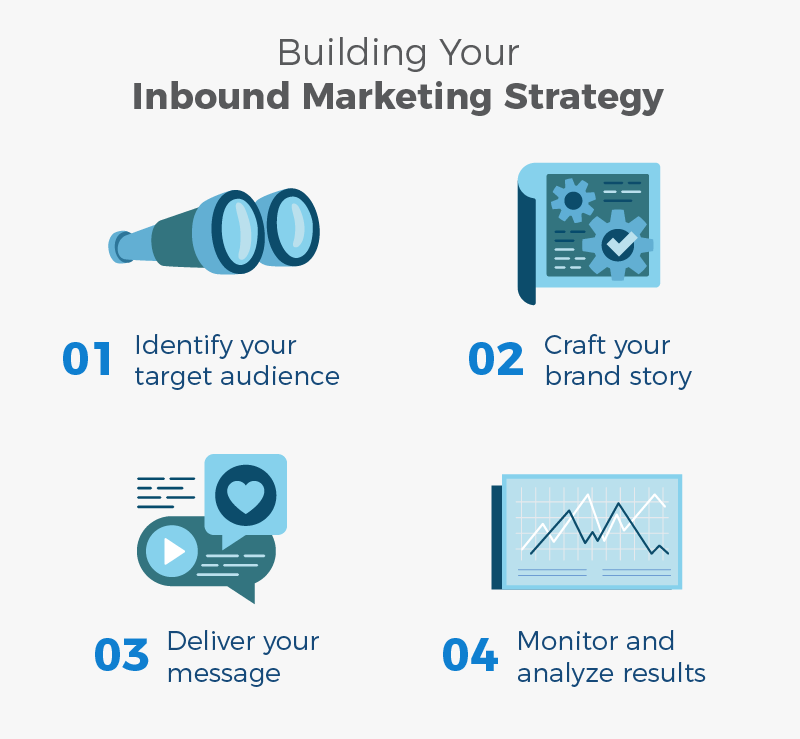If your Google search for “What is inbound marketing?” brought you here, well, that’s the perfect example of inbound marketing in action!
Simply put, inbound marketing is a digital marketing methodology that (organically) attracts traffic and leads to your site through the high-value content that you publish. It works by grabbing the attention of users who are already actively looking for content, products, or services like yours.
Does your business use inbound marketing? Learn more about how inbound marketing could help you attract more of your ideal customers. In this blog, we’ll look at the following:
- Breaking Down Inbound Marketing
- What is Outbound Marketing?
- How are Inbound Marketing and Outbound Marketing Different?
- What is an Inbound Marketing Strategy?
- Getting Started with Inbound Marketing
Breaking Down Inbound Marketing
Businesses and marketers love inbound marketing because it’s a way to draw in users rather than take the traditional approach and compete for their attention with other brands. With inbound marketing, you’ll attract your ideal audience by providing value to them from the beginning and building their trust.
In this guide, we’re breaking down how to use inbound marketing to get more traffic, leads, and, ultimately, customers.
The Inbound Marketing Flywheel
There are three components of inbound marketing that make up what we call the “Inbound Marketing Flywheel.”
These components are Attract, Engage, and Delight – and they relate to how you use inbound marketing to interact with your target audience.

Before you launch your inbound marketing strategy, you’ll want to understand what makes it stand out from other marketing methods.
Attract
Inbound marketing works by attracting new customers to your brand through content that speaks to your target audience’s wants, needs, and goals. With attraction-based blog posts, social media posts, and other types of content, you can draw in users who are actively searching for brands that offer solutions like yours.
Engage
Next, inbound marketing works to engage your audience through content that’s of interest to them. The better you understand your audience, the easier it will be to create content that entices them to take action. As a side benefit, by having your company subscribe to this methodology, you can also apply this way of thinking to your sales process. In turn, this will help build a sales culture of understanding your ideal customers, providing value, and solving problems, as opposed to spammy outreach tactics.
Delight
Finally, inbound marketing allows you to build lasting relationships with your customers. They’ll understand what your brand represents and will come to expect the highly valuable content you publish online. This makes for more trust and longer-lasting customer engagements.
Benefits of Inbound Marketing
Some pretty awesome benefits of inbound marketing include:
- Attracting your ideal target audience online
- Generating highly qualified leads for your sales team
- Improving the customer service experience for your existing followers and customers
- Building trust and lasting relationships with your audience
- Simplifying your marketing efforts
- Spending less time chasing cold leads and more time attracting warm ones
- Automating your marketing to attract more leads on autopilot
What is Outbound Marketing?
When most people think of “marketing”, they imagine outbound marketing behaviors, such as disruptive ads, cheesy sales calls, or cold emailing/texting. *Cringe* While these methods can work, they rely on you interrupting (and possibly annoying) your audience rather than attracting them to you organically.
In essence, outbound marketing refers to any type of marketing where you start the conversation.
How are Inbound Marketing and Outbound Marketing Different?

The differences between inbound and outbound marketing are subtle.
When it comes to inbound marketing, your goal is to create content that draws in traffic and fills your pipeline with new leads. With outbound marketing, you’re pushing your message out to a wide audience and essentially tracking who takes the bait.
Think of it like being at a party. Inbound marketing is when you’re having an interesting conversation, and someone overhears and joins in. Outbound marketing is walking up to them and starting the conversation yourself.
Some of the drawbacks of outbound marketing include:
- Expensive
- Time-Consuming
- Impersonal
- Difficult to Segment
- Not Aligned with Natural Buyer Behavior
- Difficult to Measure and Analyze
What is an Inbound Marketing Strategy?
If you’ve been relying on outbound marketing to get more traffic and customers, you might be realizing that this isn’t a sustainable strategy. For one, it can be frustrating for your entire team if the leads they’re getting are unqualified. Second, outbound marketing can be difficult to scale, as your sales team spends more time deciding which leads are cold and which ones are ready to buy.
An inbound marketing strategy can help your company attract high-quality leads for the long term. By utilizing many forms of marketing – content marketing, search engine optimization, social media, and email – you can increase awareness of your brand and attract new business to you.
The most effective inbound marketing strategies utilize a holistic approach by:
- Generating organic traffic through search engine optimization (SEO)
- Reaching a wider audience with content marketing both by paid and organic mediums
- Engaging followers and existing customers with great social media content
- Following up with leads through compelling email marketing and text messaging
We highly recommend taking a multidimensional approach to inbound marketing so you are sure to Attract, Engage, and Delight your audience at every step of the buyer’s journey.
Getting Started with Inbound Marketing
Wouldn’t it be nice if you had a steady stream of highly qualified leads without feeling like you are chasing people down to work with you?
With inbound marketing, you can keep your pipeline full and dignity intact. Inbound marketing is the preferred methodology because you meet your audience where they are at. It’s a much easier sell to interact with people who are already looking to work with brands like yours.
Getting started with inbound marketing is simple. Follow these steps to create your own inbound marketing strategy.

Identify Your Target Audience
First, you need to figure out who you are even trying to reach! Think about your ideal customer. What are their pain points? What are they trying to accomplish? What solutions have they tried already?
By conducting market research, you can better understand who your audience is and what they are looking for when it comes to your services or products. With this information, you can then develop a buyer persona and create content that speaks to them and catches their attention when they are already searching online.
Craft Your Brand Story
What makes your brand stand out from the competition? What do you want your audience to know about you?
Your brand story is what makes your brand unique. Some might also tie this into your Unique Selling Proposition (USP). Essentially, you want to identify what key benefits you bring to your customers that they can’t find anywhere else.
Outlining your brand story will assist you in communicating your value to potential customers. It will also ensure that your business outshines your competitors, even in a crowded online landscape.
Deliver Your Message
If you understand your target audience and what they are searching for online, then you are in a position to draw them in through content that addresses the exact things they are looking for.
For example, if you provide lead generation services for consultants and you know that your audience (consultants) are struggling to get leads, you can create content like:
- “Get Leads: 10 Lead Generation Tips for Consultants”
- “7 Mistakes Consultants Make When It Comes to Getting Leads”
- “8 Smart Ways to Get More Leads for Your Consulting Firm”
- “2020 Review: Best Lead Gen Tools for Consultants”
With highly targeted content, you can attract users from search engines, social media, and more. You know that they are already searching for content like this, so you’re in a great position to create this content and draw them in ahead of your competitors.
At the same time, you can share your brand story, customer testimonials, helpful tutorials, and more value-packed types of content to build trust with your audience. That way, they’ll better understand what you are all about and feel comfortable working with you for the long term.
Monitor and Analyze Results
A major upside of inbound marketing is that you can easily track where your leads are coming from.
For instance, if you publish a blog article titled “7 Savvy Strategies for Getting Consulting Clients”, you can use analytics software like Google Analytics to see where your traffic is coming from and track conversions.
By monitoring progress and analyzing the results, you’ll have data you can use to improve your campaigns over time. You’ll gain valuable insight into what type of content your audience likes and what entices them to convert.
A few metrics you can track in your inbound marketing campaigns include:
- Organic traffic
- Social media traffic
- Form fills
- Phone calls
- Conversion rate
- Sales
- Close rate (by sales team)
- Revenue growth
Use these metrics to set a baseline level of success and set new goals as you scale up your marketing efforts.
Implement Your Inbound Marketing Strategy
Inbound marketing is a smart marketing methodology because it meets your audience where they are at. By creating content that’s relevant to them, you can attract warm leads rather than chase down cold ones. You’ll spend less time begging and more time closing high-quality prospects.
Your goal with inbound marketing is to Attract, Engage, and Delight your audience. Take a multi-dimensional approach to reach your audience on multiple platforms, regardless of where they are in the buyer’s journey. You’ll build more trust and fill your pipeline for the long term.
Need help implementing an inbound marketing strategy? Our team is here to help you scale up your business and generate highly qualified leads online.

